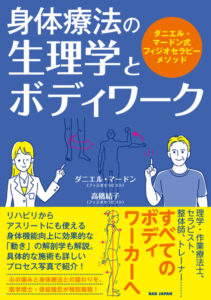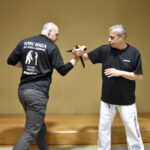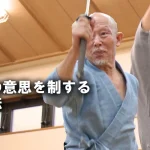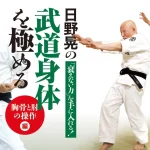【Exploring the spirit of the Ryukyu】Series 5 (HIDEN 09/2023)「Shinjo Masashi SENSEI」

Shinjo Masashi
5th -SHOBUKAN SOHONBU DOJO-
A VINTAGE DOJO, INTACT AFTER 60 YEARS!
Founded by Shinjo Masanobu Hanshi 10th Dan (1937-1993) in 1963, this Dojo is situated in Yaeshima, between Kadena base and the former “Red-Light district” in Okinawa City…
Hanshi Shinjo Masanobu studied under 2 famous Karateka:
-1) Toguchi Seikichi (1917-1998), who was the senior disciple of Goju-ryu founder; Miyagi Chojun (1888-1953).
-2) Higa Seko (1898-1966), disciple of Higaonna Kanryo (creator of Naha-Te) who was also “Kyodai Deshi” of Miyagi Chojun.
Shinjo Masanobu Sensei had tremendous muscular strength, which got him the nickname of “The strong man of Okinawa”.
He was internationally recognized as a fine technician and his mastering of Kata and techniques made him compared to Miyagi Chojun.
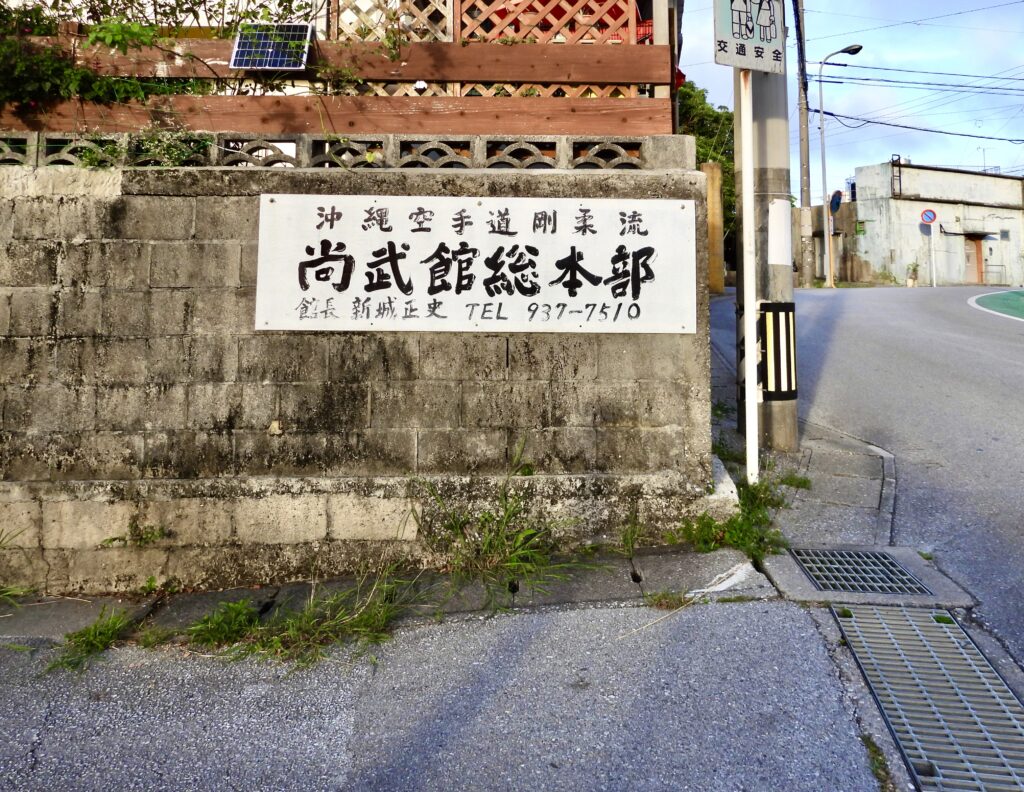
Time travel… If you took a left at this Shobukan Dojo sign, you were engaging into a dead-end and ready for rigorous Karate training. Going straight was leading to fun bars & restaurants for the US military mostly. The contrast was so big that this intersection was called “Yaeshima of flowers” and “Shobukan of demons”.
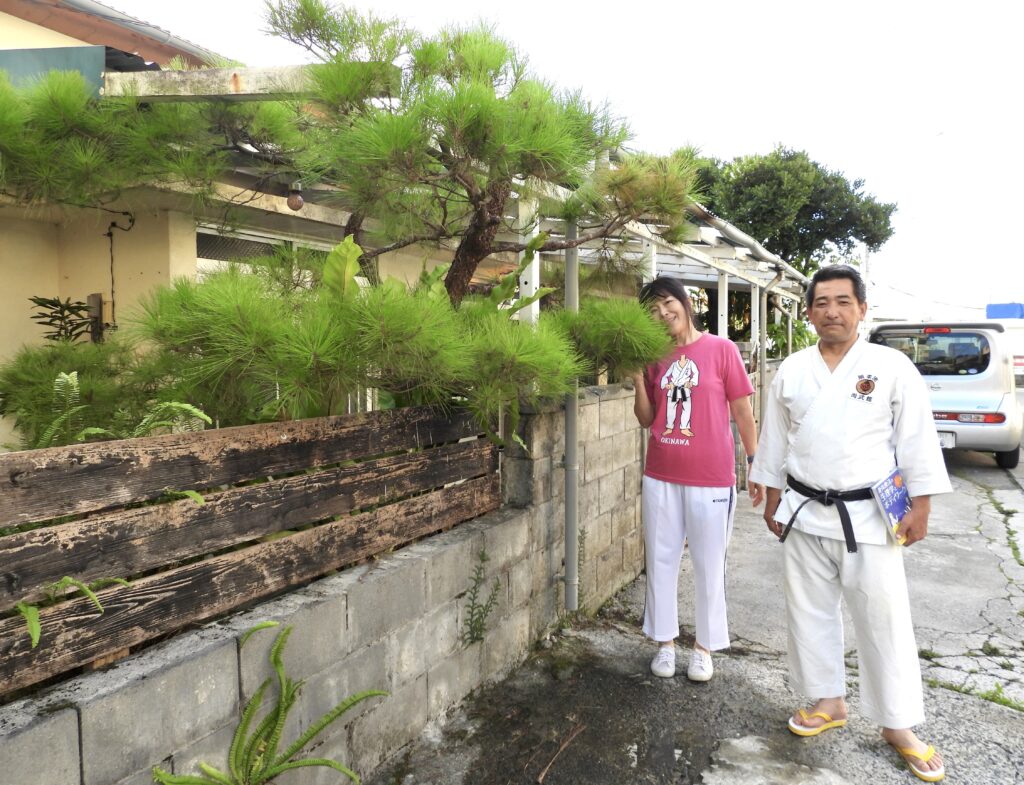
Dead End and demons.

When the dojo opened in 1963, this hand-made sign was offered by a friend of Masanobu Shinjo Sensei. It still welcomes disciples today. Masashi Shinjo Sensei (left) and Daniel Sensei(right).
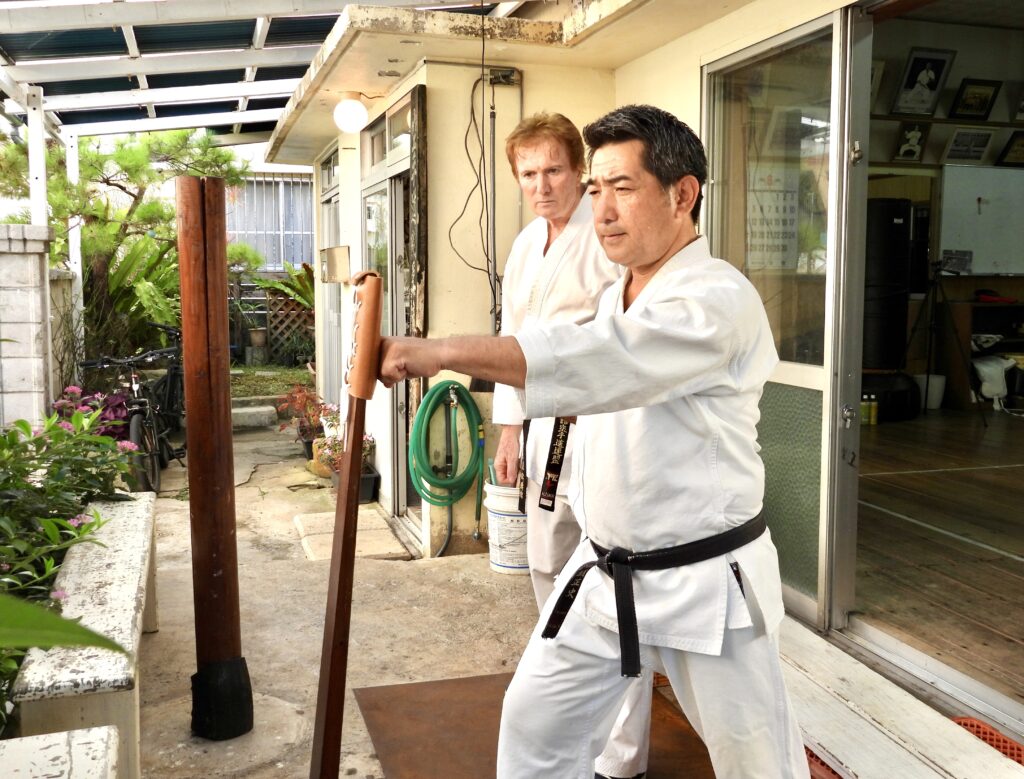
Teaching Makiwara . Ten thousand hardening makes a firm fist.

Practicing Kakiè (arm against arm) Training chudan and gedan uke.
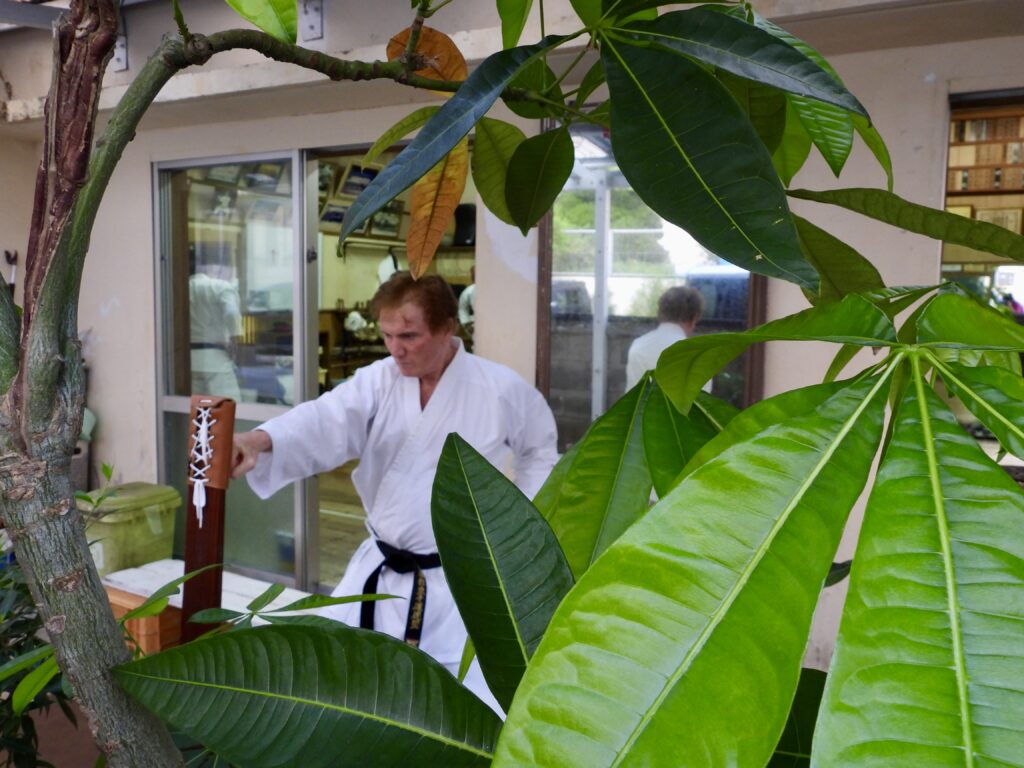
Working at a “Flat-Makiwara” under an old ebony tree.
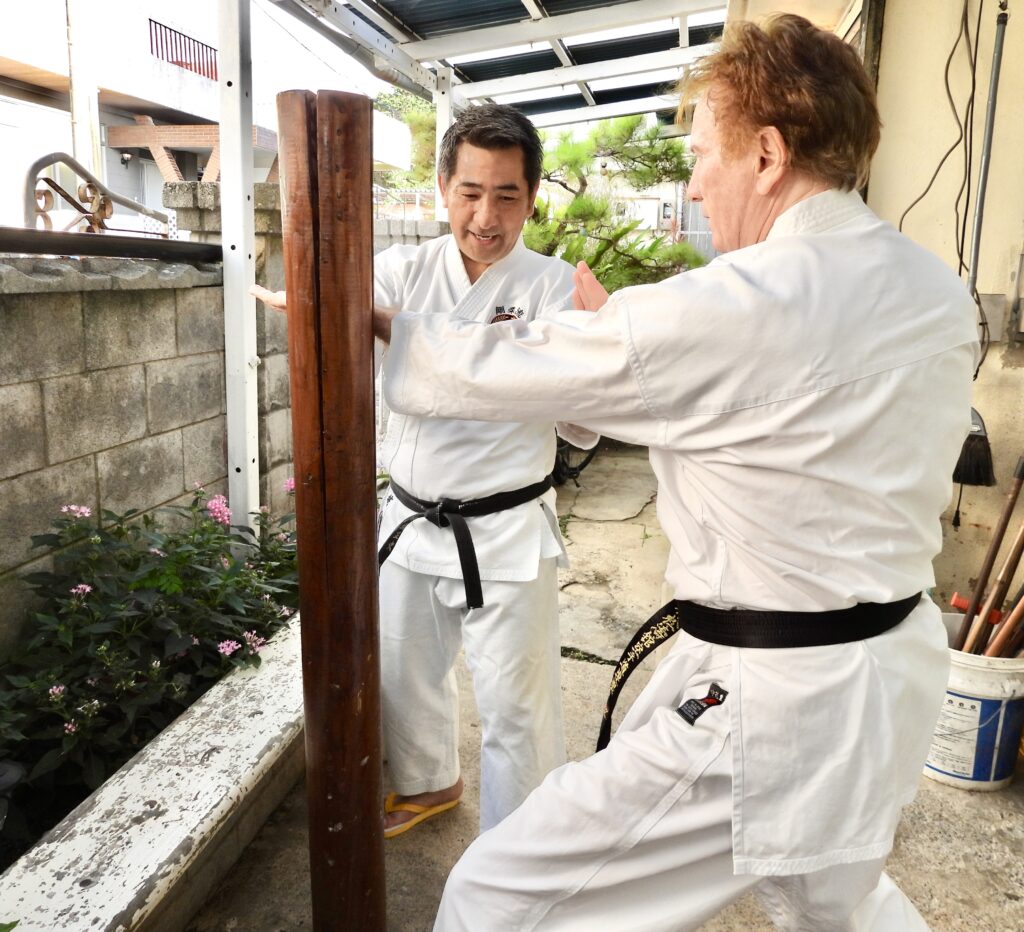
The round “Ude makiwara” allows additional techniques like arm-blocks.
Sadly, Shinjo Masanobu sensei passed away in 1993 at the age of 56. He was serving as the president of the All-Okinawa Karatedo Federation. In order to manage a Karate Dojo in Okinawa, you need to have a 5th Dan. The reason is that most Dojo often serve as the headquarters for a related association.
Since his elder son Shinjo Masashi was still too young to become the new Kancho of the Dojo, Takushi Seiki (Kobudo 10th Dan and Karate 9th Dan), was named to run the Dojo and the Association until 2005, when Masashi Sensei obtain his 5th Dan. At 83, Takushi Sensei is still the advisor of the Shobukan Sohonbu Dojo.
It is another very hot Summer evening for this training-interview and as you know by reading my articles, there is no A/C in Okinawa Dojo… The tiny tropical garden in the front only gives an illusion of coolness. A large ebony tree which was planted when the Dojo was built stands next to a beautiful Ryukyu pine tree.

Biography of Shinjo Masashi
Director of Okinawa Karatedo Goju-ryu Shobukan General Headquarters.
Director of the All-Okinawa Karatedo Federation.
President of Okinawa Karatedo Goju-ryu Goju-kai.

Instruction is done with precision. Daniel Sensei also participates in the Kata Seipai (18 hands).
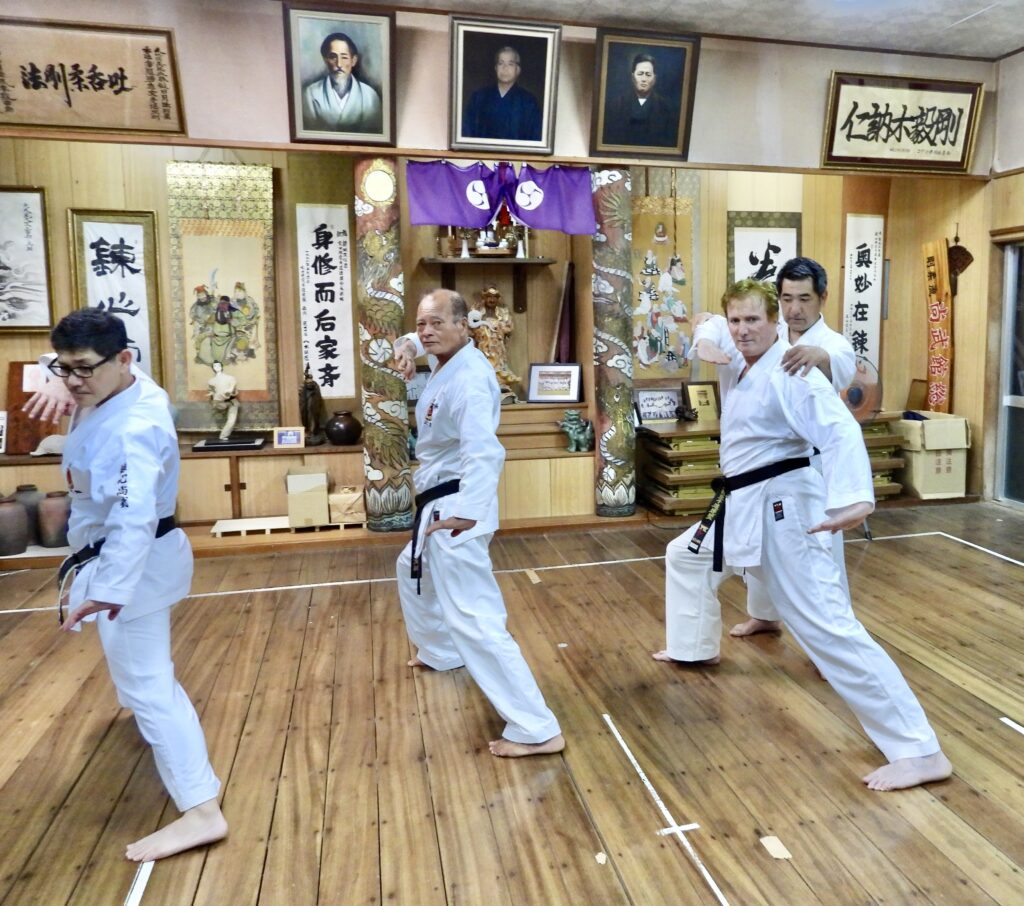
Goju-Ryu is not easy!
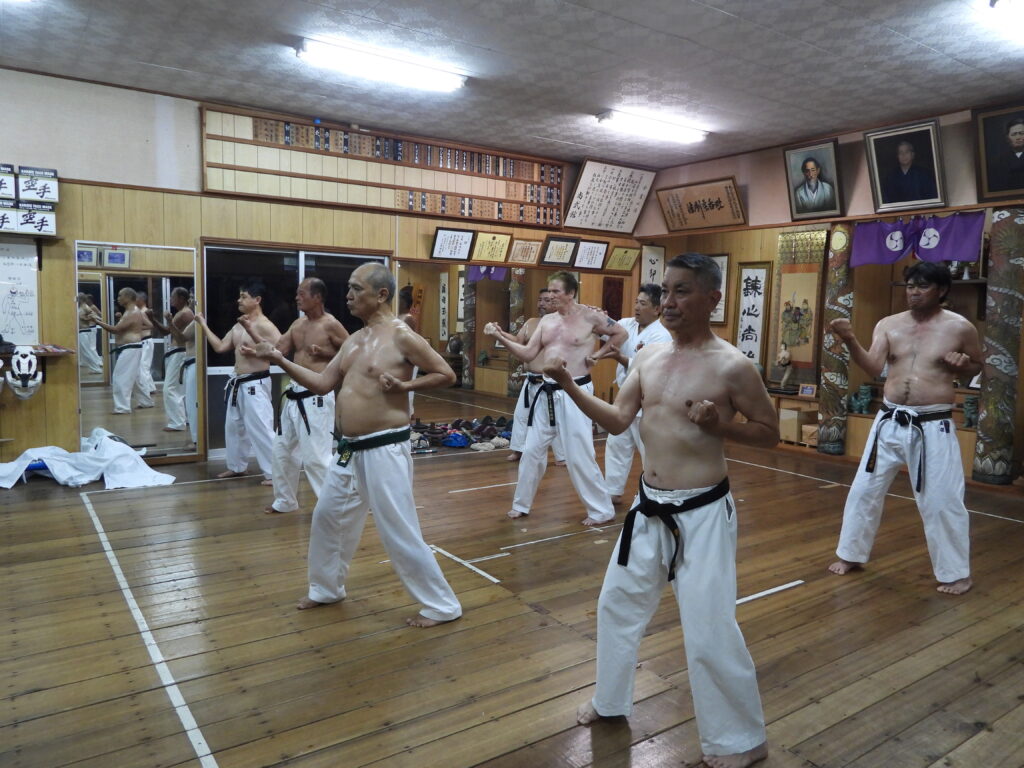
Sanchin training
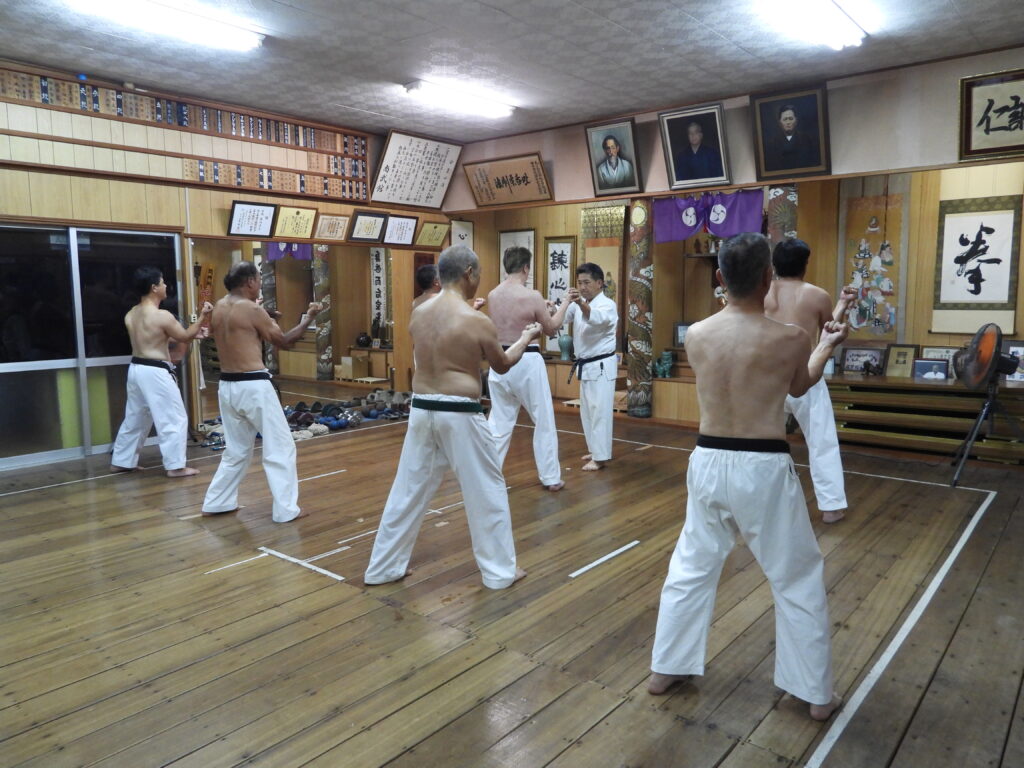
Sanchin training
(1-) Why did you start karate?
My father, Masanobu Shinjo, opened this Dojo in 1963 when he was 25. I was therefore born in a house with a Dojo and I grew up in an environment where karate was familiar to me. As soon as I stood up, I knocked on the door, but it was really at the age of 10 that I started. At that time, fewer children were taking karate than now, so I practiced mostly with adults.
—Do you know how your father started karate?
My father, who had practiced Judo in high school, discovered Toguchi Sensei’s Dojo, in Nakanomachi, in the area we broadly call Koza nowadays. Higa Sensei was also teaching at this Dojo, so my father decided to learn Karate with these 2 famous teachers.
At that time,Toguchi Seikichi and Higa Seko Sensei were living about 1 mile away, in the district of Yaeshima. It is important to say that right after the war, Yaeshima had become a very popular area since it was close to the main gate of Kadena US military base. It was a fun place to live with new opportunities. Many “A sign bars” (Approved by U.S. military) were opening in the tiny and tortuous roads of the valley behind. People were coming from all over Okinawa to do business. Actually, the Shobukan Dojo and my house were built right across where that gate used to be post-war. That gate was moved a few hundred yards South in the late 50’s.
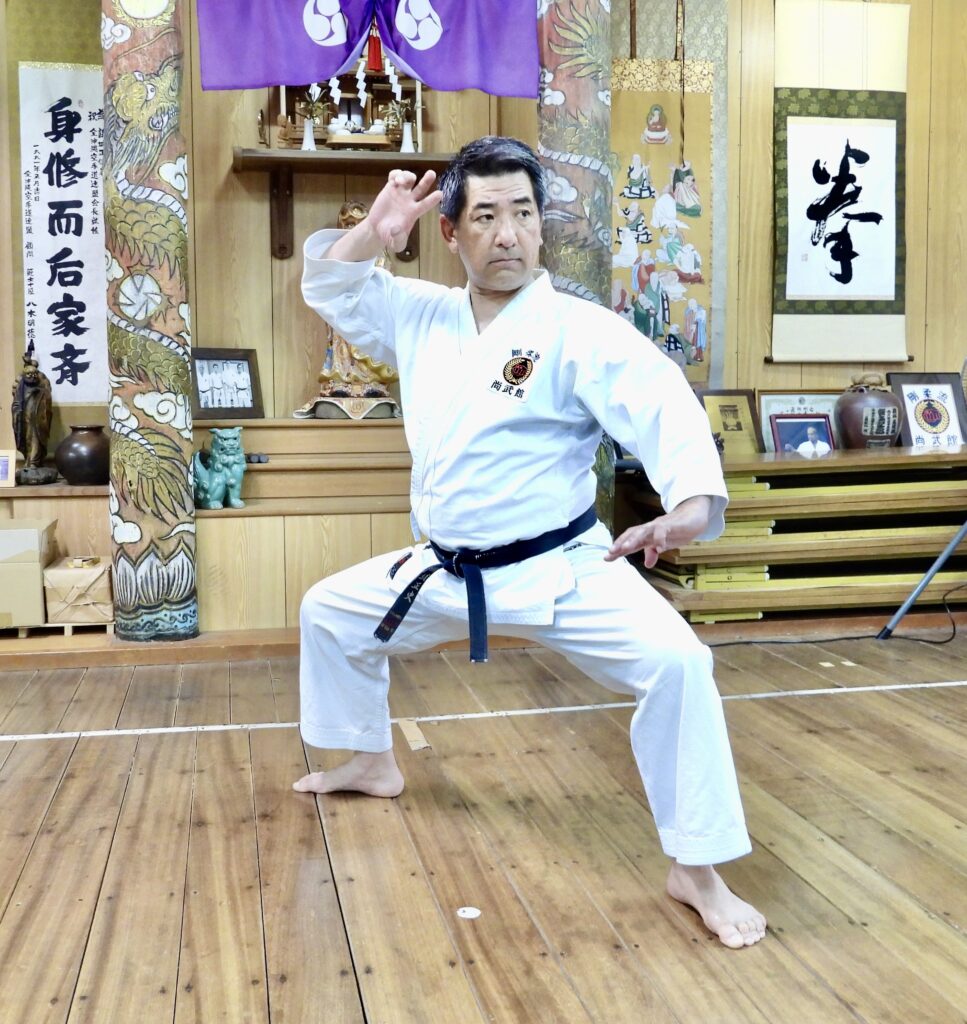
Pose Seinchin’s Kata.
(2-) What are the characteristics of your school (Dojo)?
“Okinawa Traditional Karate Goju-ryu”, as its name suggests, is a Ryuha (style) based on the harmony of hardness and softness.
Goju-Ryu comes from the association of “Go” 剛 (hard) and “Ju” 柔 (soft). “Go” usually represents strong linear strikes, using closed-hand techniques while exhaling. “Ju” is more about open-hand circular blocks and movements while inhaling. Breathing correctly is the emphasis of this style.
(3-) What is your favorite Waza and Kata?
My favorite Kata are “Seienchin” and “Seisan”.
(4-) What is your most impressive memory of your Sensei/(Shisho)?
My father, who was my Shisho, was a very quiet, honest, serious and passionate person. He was the type to immerse himself in whatever he was doing. At that time, Karate was taught in the traditional Okinawan style of “watch and learn” rather than step by step assisted instruction. I think that he was influenced by his masters Toguchi and Higa Sensei.
My father was at the Dojo from morning till night. Disciples were coming all the time, so he couldn’t do his own training. So, when no one was coming, he would concentrate on his own practice.
He was what we call today a “minimalist” and he didn’t even have a driver’s license. He didn’t want anything other than what is needed for karate. He was not interested in superfluity at all… That’s the kind of person he was. It seems that the only thing he was interested in was Sanchin.

Masanobu Shinjo and his 3-year-old son Masashi.
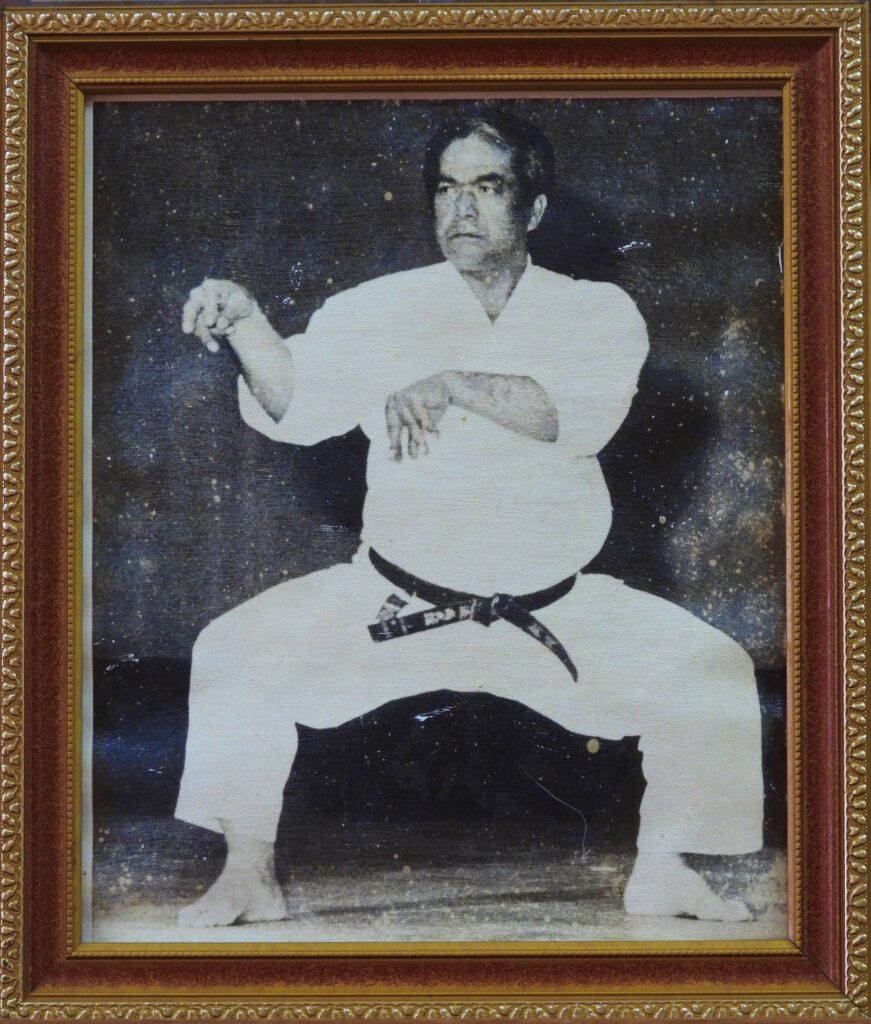
“The strong man of Okinawa”.
(5-) What is the difference between Okinawa Karate and mainland Karate?
I think the difference is not so much about the Karate styles, but rather about semantics and language…The Ryukyu language didn’t travel as well as the techniques. Our Masters of the past went to Mainland Japan to teach their Karate, but even fifty years ago, most Karate Sensei didn’t speak standard Japanese! They were teaching in Uchināguchi; our Okinawan dialect. Moreover, Okinawa karate was only taught by “Kuden” 口伝 (verbally/orally) and accompanied by “Ougi” 奥義 (revelations, subtleties) and “Hiden” 秘伝 (secrets passed on by Masters only)…
All this brought confusion to the standard student and many parts of the special teachings were not well conveyed.
For example, if your Sensei is saying; “ヤールー“Yaru” position or “マヤー”Maya” position, you won’t get it right! “Yaru” means gecko and “Maya” means cat….
Besides the loss in translation, there is the cultural factor. Asking a city person “walk like a gecko” or “move like a cat” was not meaningful. Same with “Gamaku”, even if this word is becoming trendy today [and I know Daniel loves it and is spreading it! lol]. When a Sensei tells to engage the “Gamaku”, most people, including the locals, have no idea of what it is.
Therefore, even when students were learning Karate at big Japanese universities, most of them could not understand the true meaning of Karate. It seems that some Sensei had to return to Okinawa because they could not convey the true meaning of the words even though they tried their best to teach their Karate.
In addition, there are things that cannot be learned without the “climate” and “atmosphere” of the Okinawa islands. Mainland Japan air and weather are different and this is even more true for foreign countries.
(6-) Do you often teach to foreigners?
Nothing like we used to do, but Shobukan has 17 satellite Dojo. 1 is situated in Kochi Prefecture, 14 dojos are in the US, 1 dojo in Brazil, and 1 dojo in India. We do have the regular visit of the members from each branch that are free to come to the Hombu Dojo in Okinawa and to train with us.
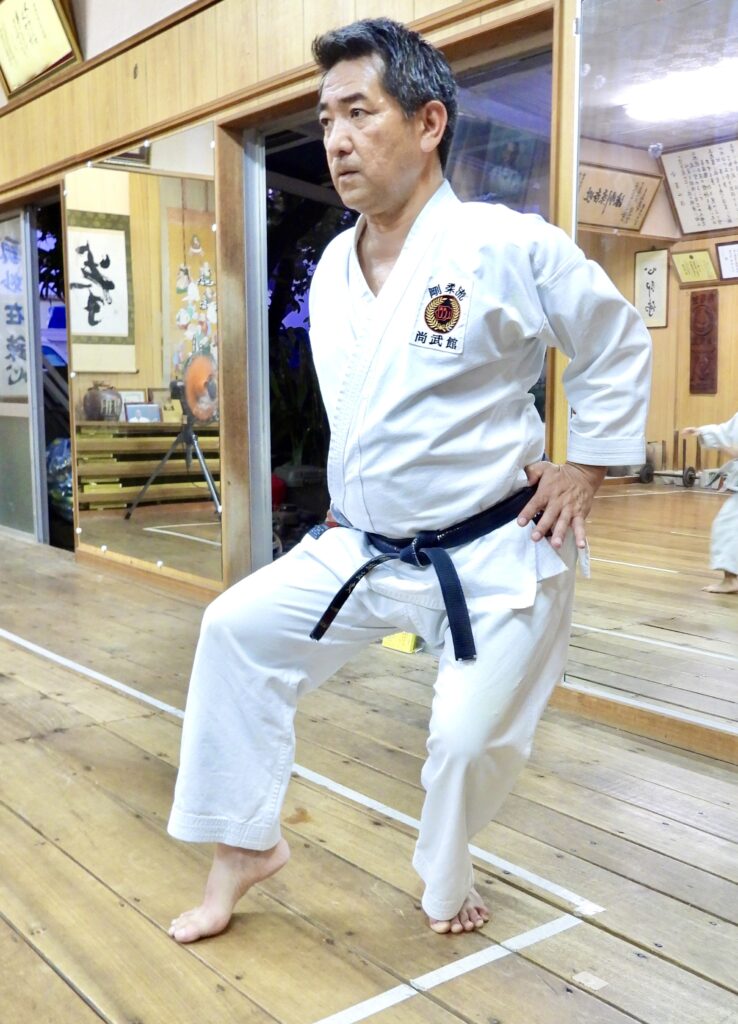
“Maya” Neko ashi dachi is a unique step from Goju-ryu.
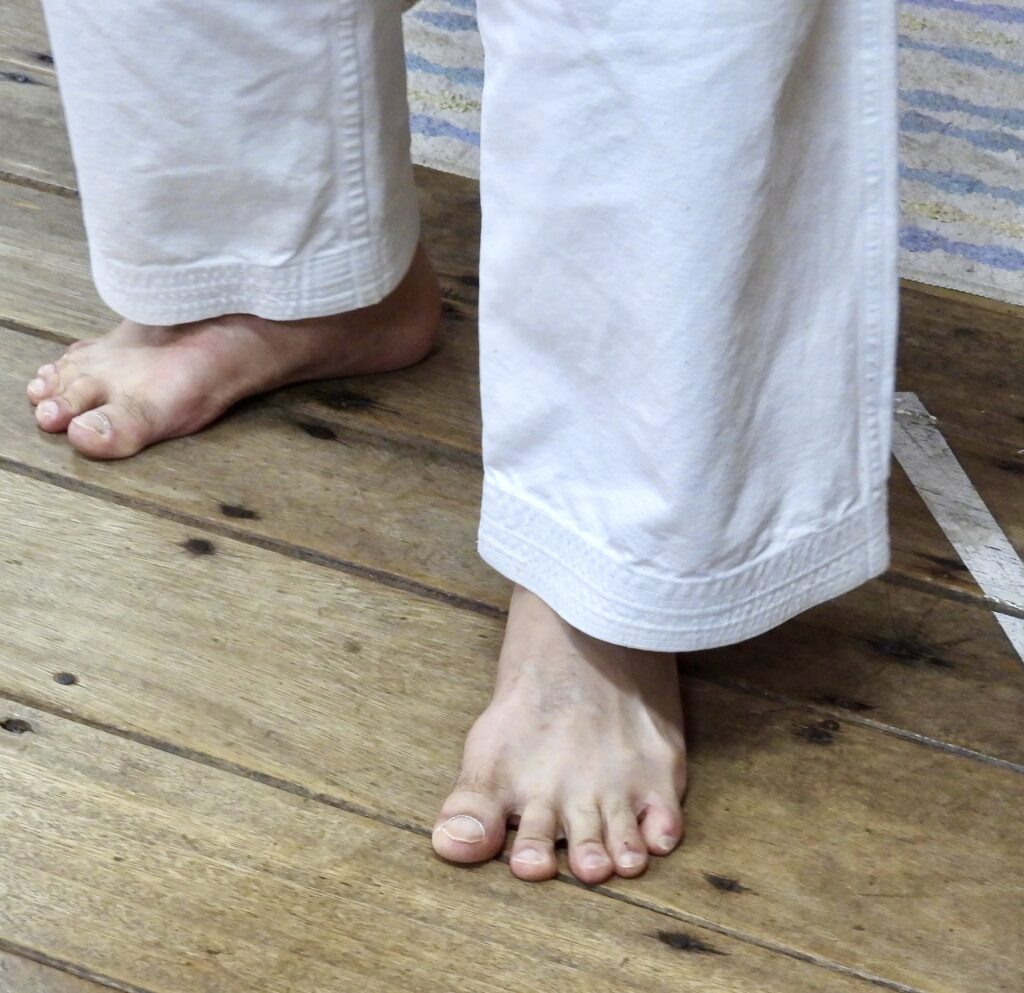
At Shobukan, disciples are thoroughly trained to stand like a gecko (yaru) grasping the floor.
(7-) What do you think about the global rise of Karate today?
“I am very happy.” If possible, I would like karate enthusiasts from all over the world to experience authentic Okinawan traditional karate, which is part of everyday’s life in Okinawa, and bring it back to their countries to spread it.
(8-) What do you think about Karate becoming a competitive sport, including the Olympics?
I think the exposure of Karate during the Olympics had a great effect. This is definitely a plus for the Karate world. As for making it a competitive sport, I think it would be good for students and children to practice Karate as a competitive sport.
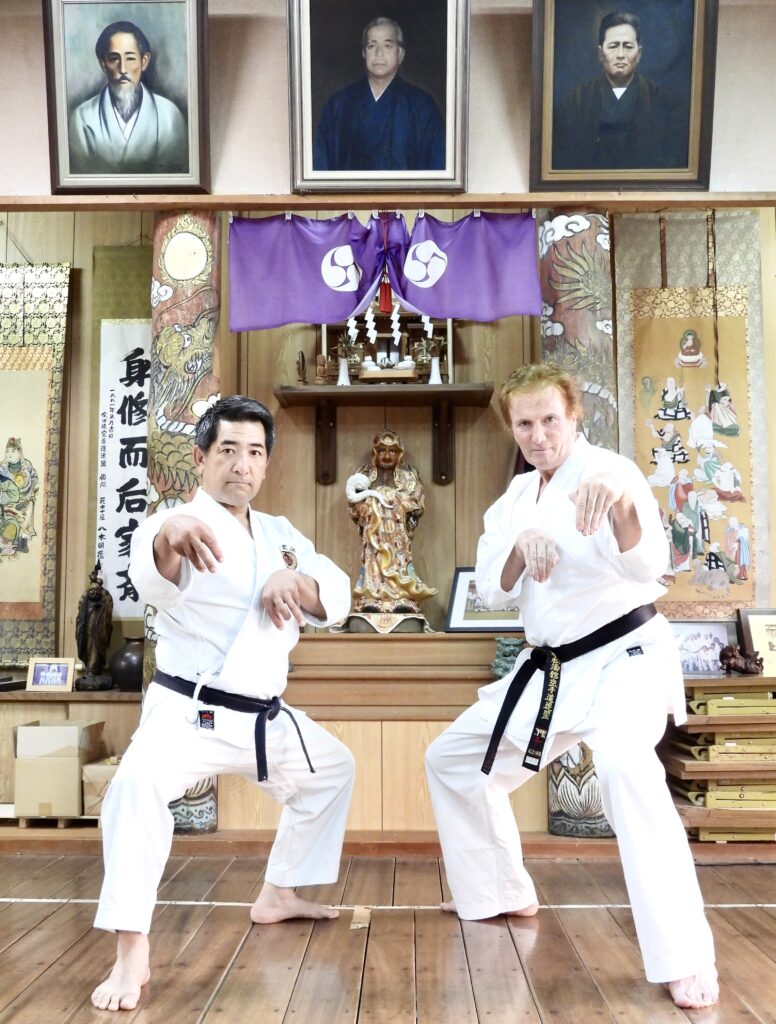
A pose from Suparinpei Kata. In the old days, it was said to hold hands like a dog.
(9-) What is the significance of Karate as a martial art nowadays?
Even if times have changed, the correct formation of a personality will not change. I think that Karate is still a very suitable martial-art for mental training in modern times. I sincerely believe that Karate is something that you build up and it will return to your life in some form.
(10-) How do you envision the future of Karate?
I think it will spread all over the world through the Internet.
(11-) Do you have any message for the world?
Karate is a martial art that values “Wa” 和 (Harmony, mutual respect, peace, calm) I believe that by spreading Karate around the world, wars and conflicts will disappear.
(12-) What does “karate” mean to you?
“It’s something that has been around me since I was born.”
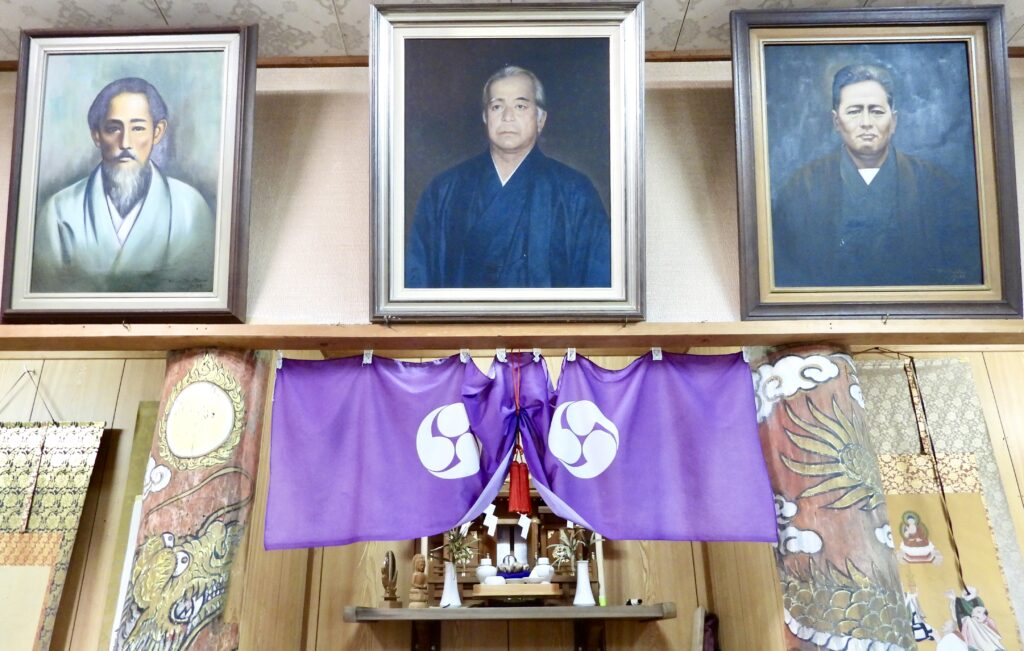
3 generations; Higaonna Kanryo, Shinjo Masanobu and Miyagi Chojun.

At Shobukan, students from all ages (children to seniors) train hard every day.
Daniel Sensei’s conclusion:
In this interview, I was very happy to see a form of Karate that uses advanced physical knowledge, biomechanics and breathing techniques. The emphasis on foot positioning in particular. How it affects the movement of the whole body! I had heard this from the great ballet choreographer Maurice Béjart and I always thought it should be applied to Karate. Those of you who have read my books know that my body was damaged earlier than normal by “modern Karate”. I did overuse it, but still! Many of my Karate friends from the same generation also suffer from arthritis.
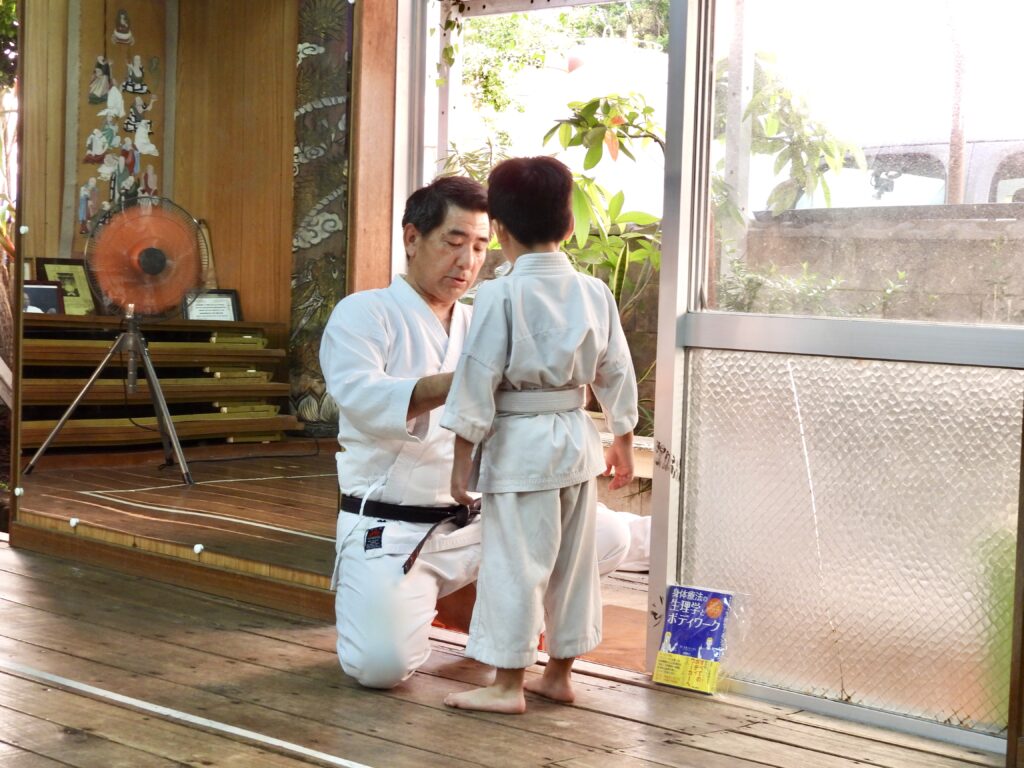
I remember a saying; “A father is 10 brothers and a Master is 10 fathers…”
There is a new trendy rhetoric claiming that a teacher can only bring 10% and that the practitioner must develop himself the 90% remaining from the seeds… This sounds like a lazy way of not taking responsibilities and a lack of professionalism.
Finally, I would like to say that France was the first country in Europe to open a Karate Dojo, but unlike American Karate, French Karate was not shipped directly from Okinawa, and was quite different. Many French people who learned Karate and became teachers had to learn with their own interpretations from Japanese teachers. They had to face greater cultural and language barriers than the Japanese experienced with the Okinawan Sensei.
Even if the biomechanics were inappropriate at times, it would have been wrapped in a veil of fascination with foreign cultures.
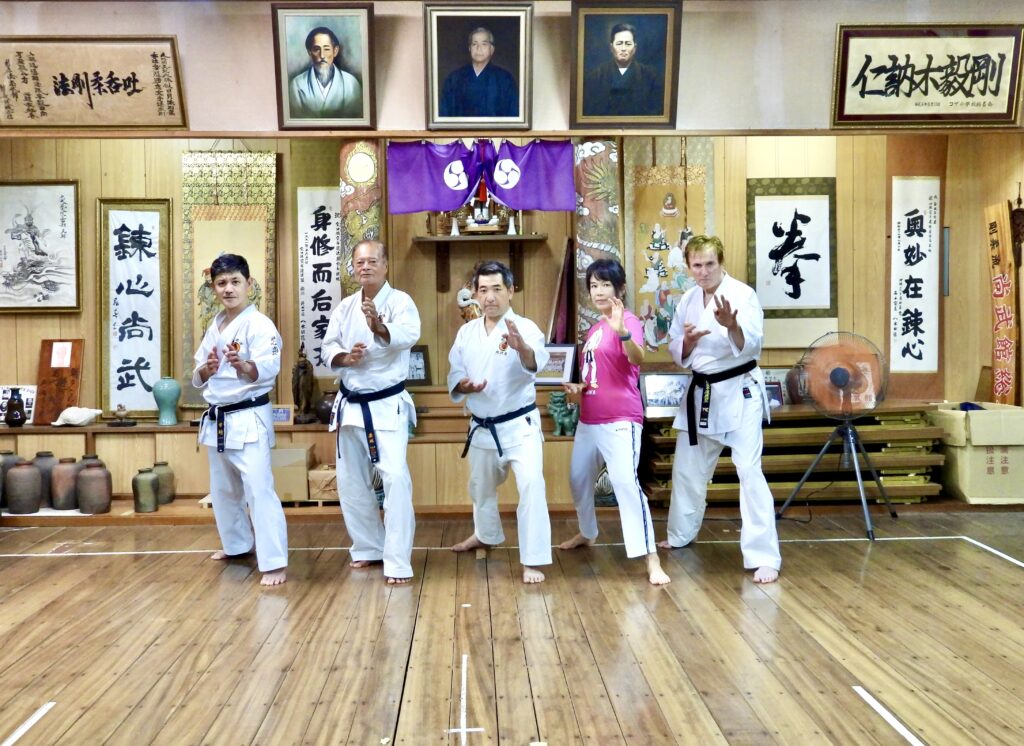
It has been a long evening… Thanks to all!
For my generation, the idea was basically: “if you can’t do it, you’re weak!” However, I cannot say that the teaching method was entirely wrong because some teachers really cared. Let’s say that Karate is still a real challenge to pass on and is often the victim of good intentions with bad methods… These experiences inspired me to explore the body and made me become a therapist. I really recommend studying the true physical effect of Karate on the body before considering its possible effects on the mind.

Daniel Mardon; the Karateka-Therapist
Creator of Aromapressure® method and physiotherapist with a valid US license, Daniel Mardon was born in Paris. One of his specialties is to teach and to perform lymphedema and subcutaneous tissue-damage care, after radiotherapy for cancer patients at medical institutions and subcutaneous tissue-circulation stimulation before and after surgery.
He was also a therapist for two famous soccer teams in Paris. Since 2005, he has focused on producing top-class hotel spas in Japan, as well as physiotherapy education and awareness-raising activities for health care professionals. Author of several books, among his major publications includes “The Physiology and Bodywork of Physical Therapy ” (Published by BAB Japan) and DVD “Daniel Mardon Aromapressure® Method ” (Pony Canyon). He regularly appears on television and radio shows, and has featured in numerous media publications.

